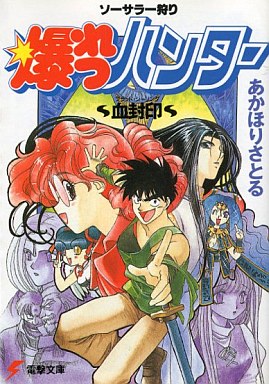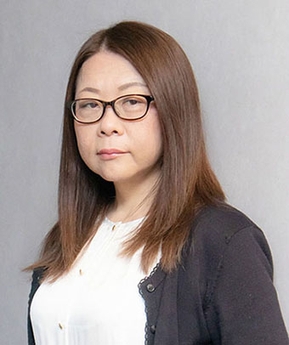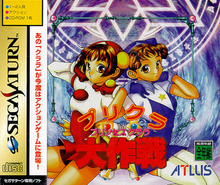
Virtua Fighter is a fighting game created for the Sega Model 1 arcade platform by AM2, a development group within Sega, headed by Yu Suzuki. An early prototype version was location tested in Japan by August 1993, before the complete game was released worldwide in December 1993. It was the first arcade fighting game to feature fully 3D polygon graphics. The game was ported to Sega Saturn as a global launch title in 1994 and 1995, and also received a port to the Sega 32X.

A photo booth is a vending machine or modern kiosk that contains an automated, usually coin-operated, camera and film processor. Today, the vast majority of photo booths are digital.

Sega AM Research & Development No. 2, previously known as SEGA-AM2 Co., Ltd., is a video game development team within the Japanese multinational video game developer Sega. Yu Suzuki, who had previously developed arcade games for Sega including Hang-On and Out Run, was the first manager of the department.

Sorcerer Hunters is a Japanese light novel and manga series, written by Satoru Akahori and illustrated by Ray Omishi. Akahori and Omishi also published Sorcerer Hunters Special, a one-volume story set sometime after the series' conclusion.

Power Instinct, released in Japan as Gōketsuji Ichizoku, is a fighting video game series created by Atlus.

Castle of Illusion Starring Mickey Mouse is a 1990 platform game developed and published by Sega and released for the Mega Drive/Genesis. An 8-bit version of the game was later released for the Master System and Game Gear. The game follows Mickey Mouse on a quest to save Minnie Mouse from the evil witch Mizrabel. It is the first game in Sega's Illusion video game series starring Mickey.

SegaSonic the Hedgehog is a 1993 arcade game in the Sonic the Hedgehog series by Sega. Controlling Sonic the Hedgehog and his friends Mighty the Armadillo and Ray the Flying Squirrel, the player must escape an island after they are kidnapped by the villain, Doctor Eggman. The game uses an isometric perspective. Players use a trackball to move the characters while dodging obstacles and collecting rings. The game was developed by Sega's arcade division, Sega AM3. It is one of four Sonic games with the SegaSonic name and was inspired by the 1984 game Marble Madness.

Rad Mobile is a racing arcade game developed by Sega AM3 and published by Sega. It was first published in Japan in October 1990, followed by an international release for arcades in February 1991. Rad Mobile was Sega's first 32-bit game, using Sega's System 32 arcade system board. It was also the first ever appearance of Sonic the Hedgehog, who appears as an ornament hanging from the driver's rearview mirror.

DonPachi is a 1995 vertical-scrolling shooter arcade game developed by Cave and published by Atlus in Japan. Players assume the role of a recruit selected to take part in a secret military program by assaulting enemy strongholds in order to become a member of the "DonPachi Squadron".

Sega AM Research & Development No. 1 is a development department within Japanese toy and amusement game company Sega Fave that also previously existed as Wow Entertainment and Sega Wow Inc. AM1 spent most of its early existence under the leadership of Rikiya Nakagawa and developed a number of arcade games for Sega.

Rieko Kodama, also known as Phoenix Rie, was a Japanese video game artist, director, and producer employed by Sega from 1984 until her death. She is primarily known for her work on role-playing video games including the original Phantasy Star series, the 7th Dragon series, and Skies of Arcadia (2000). She is often recognized as one of the first successful women in the video game industry.

Panzer Dragoon is a series of video games developed and published by Sega. The first three games — Panzer Dragoon (1995), Panzer Dragoon II Zwei (1996), and Panzer Dragoon Saga (1998) — were produced by Team Andromeda for the Sega Saturn. The fourth, Panzer Dragoon Orta (2002), was developed by Smilebit for the Xbox. Spin-offs include Panzer Dragoon Mini (1996) for the handheld Game Gear in Japan. A remake of Panzer Dragoon was released in 2020.

Sorcer Striker is a 1993 vertically scrolling shooter arcade video game developed by Raizing and published in 1993 by Able Corporation in Japan and Europe. In the game, players assume the role from one of the four bounty hunters to overthrow the Goblin empire led by King Gobligan and reclaim the bounty placed by King Codwenna of Violent Kingdom over Gobligan's head. It is the first entry in the Mahō Daisakusen trilogy, which includes Kingdom Grand Prix and Dimahoo, and the first video game to be created by Raizing.

This is a list of development studios owned by Sega, a Japanese video game developer and publisher based in Tokyo, Japan. Accompanied with the list is their history of game development. Also included are the companies that Sega has acquired over the years. For a full list of games developed and published by Sega, see List of Sega video games, List of Sega mobile games and List of Sega arcade games.

Sega Corporation is a Japanese multinational video game company and subsidiary of Sega Sammy Holdings headquartered in Shinagawa, Tokyo. It produces several multi-million-selling game franchises for arcades and consoles, including Sonic the Hedgehog, Angry Birds, Phantasy Star, Puyo Puyo, Super Monkey Ball, Total War, Virtua Fighter, Megami Tensei, Sakura Wars, Persona, and Yakuza. From 1983 until 2001, Sega also developed its own consoles.
Tanken Driland is a Japanese mobile game developed by GREE, Inc. A manga adaptation began serialization in Jump Square in 2012. An anime series by Toei Animation and TV Tokyo began airing on 7 July 2012.

Puzzle & Action: Ichidant-R (also known as just Ichidant-R is a puzzle video game developed and released by Sega in 1994 for the Sega System C-2. It is the sequel to Puzzle & Action: Tant-R and is the second of the Puzzle & Action series. Gameplay is similar to Tant-R: the player must complete a series of mini-games, although its crime theme is replaced with a medieval theme. The detectives from the first game return and play the role of knights in a theatre play. An English version of the game exists, which replaces the Japanese voices with English voices. The Korean version also uses the English voices. The game was ported to the Game Gear in 1994, Mega Drive in 1995, and released on the Sega AgesRouka ni Ichidant-R compilation for the Sega Saturn. The game was released for the Wii Virtual Console in 2007. All console versions except for the Switch version are Japanese exclusives. The third and final game in the series, Puzzle & Action: Treasure Hunt, was released in 1995.

ESP Ra.De. is a 1998 vertical-scrolling bullet hell arcade game originally developed by Cave and co-published by Atlus and Nihon System in Japan. Set in the year 2018, players assume the role from one of the three ESPers to overthrow Lady Garra and her Yaska syndicate from taking over Tokyo.

















